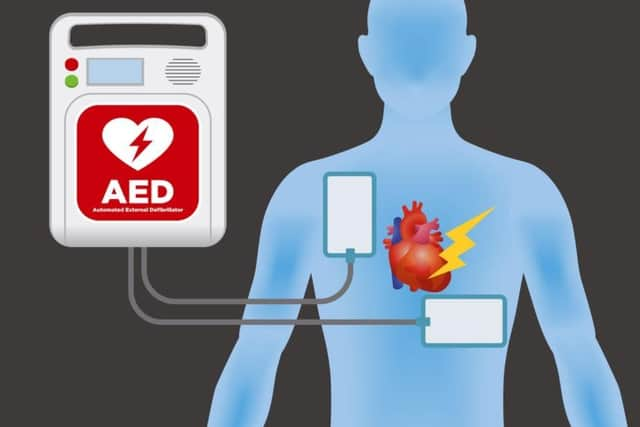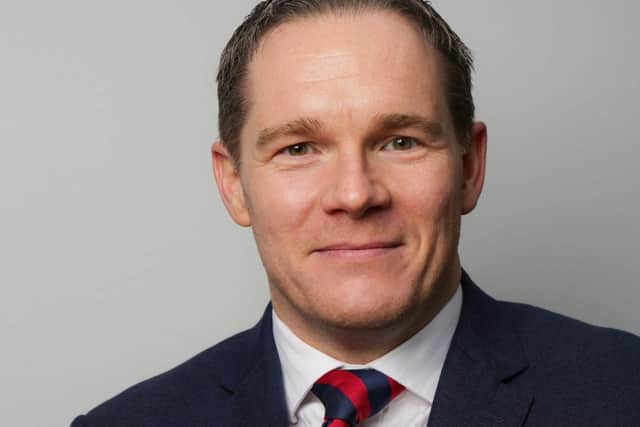Christian Eriksen offers a wake-up call for everyone
and live on Freeview channel 276
The events of Christian Eriksen’s collapse and cardiac arrest on a football pitch in front of millions have stunned the world and led many people to question their own mortality and heart health.
If a super-fit 29-year-old, who has played elite sport for so long, can just ‘die’, then where does that leave us mere mortals?
Advertisement
Hide AdAdvertisement
Hide AdSo what actually happened to Eriksen and how does this differ to your average punter in the street collapsing and dying? There are some major differences and many potential causes.


To clarify the event, Eriksen suffered his collapse on the pitch because not enough blood was being pumped to his brain and his blood pressure was very low.
This was very likely due to his heart electrics malfunctioning. His heart was probably beating in a very fast, abnormal rhythm called ventricular fibrillation. This cannot sustain any pumping output and the only way out is defibrillation.
This is performed by a £900 device called an automated external defibrillator (AED) which can safely deliver electrical energy of around 200 joules through the heart, completely disrupting the chaos and literally shocking the heart back to its normal electrical rhythm (sinus rhythm).
Advertisement
Hide AdAdvertisement
Hide AdThere are many reasons why a person’s heart can end up in ventricular fibrillation. Once you are over 35 years of age, the main cause is often a heart attack, where the blood flow down the heart arteries has been compromised by a clot or blockage.


In people under the age of 35, or people engaging in sport, it tends to be a cardiomyopathy, disease of the heart muscle itself.
This can be due to an underlying genetic abnormality where you heart is ‘programmed’ to thicken too much, or to dilate excessively or to have internal scarring which disrupts the normal electrical flow.
This can be found by simple tests such as a 12-lead electrocardiogram or ultrasound scan of the heart (an echocardiogram). In rarer cases, and possibly the reason for Eriksen’s collapse, is a condition called a channelopathy. This means there is a problem with how the heart deals with its own salts on a microscopic level and this can influence how the heart generates and conducts its own electricity.
Advertisement
Hide AdAdvertisement
Hide AdThese account for 40 per cent of sudden cardiac death in under 35-year-olds. Sadly, trying to screen for channelopathies is like looking for the proverbial needle in the haystack.
Even if you didn’t find something in extensive genetic screens or testing the heart electrics, it is still possible in 30 per cent of completed or aborted sudden death cases, that no cause is found and this is labelled as being idiopathic (of unknown cause).
Five hundred people die in the UK each year of Sudden Arrythmic Death Syndrome (SADS) – many are young and this is in addition to the 160,000 people who die of general heart disease in the UK each year. One person every eight minutes.
So, what can we control and what should we do to try to avoid dying young and suddenly?
Advertisement
Hide AdAdvertisement
Hide AdWell, in 50 per cent of cases genes play a large role and, indeed, they load the gun.
However, in many circumstances, the other 50 per cent is your lifestyle and environment, your daily actions and your habits that pull the trigger. Perhaps my own grandfather would not have had a heart attack in his 60s had he not eaten sugar and fat like a champion, smoked like a beagle and drunk booze like a fish. It is important that people are mindful of their family cues.
You are essentially 50 per cent mum and 50 per cent dad and given that we can’t choose our parents, their morbidity and mortality could be a guide to what may be in the pipeline for us if we follow their lifestyle too. A
Also brothers and sisters can give clues as well. If someone has had a sudden death, heart attack, stent or bypass, then it is time to get checked out and to take evasive action, with what you can control – your lifestyle and environment.
Advertisement
Hide AdAdvertisement
Hide AdThis brings me to a more societal role for prevention. The only way to save a life in the circumstances we witnessed in the European Championships, is to learn cardiopulmonary resuscitation (CPR) and to teach your kids and friends. It is very easy and there are many videos online which can help teach the basics. Kneel next to the person; place the heel of one hand in the centre of their chest and place your other hand on top of the first. Interlock your fingers.
With straight arms, use the heel of your hand to push the breastbone down firmly and smoothly, so the chest is pressed down between 5cm–6 cm, and release. Do this at a rate of 100 to 120 chest compressions per minute – that’s around two per second.
Even though CPR can keep someone alive, early defibrillation is the key moment and this is why we must look at how we flood the modern world with these relatively inexpensive devices.
They should be as visible as fire extinguishers, with people trained to operate them in workplaces.
Advertisement
Hide AdAdvertisement
Hide AdYou don’t need to be a doctor to operate a defibrillator these days, they are automated and take you through the steps, even diagnosing if a shock is advised.
They offer the real chance to give divine intervention and save a life. So, in memory of all the Christian Eriksens who did not get early CPR and defibrillation, do your bit and influence your own lifestyle and environment but also ask why there is not a defibrillator near you now.
Dr Scott Murray is a cardiologist and medical director of Venturi Cardiology. He is one of the nation’s leading experts in preventative cardiology. If you have concerns or worries about your heart, or a previous heart condition, www.venturicardiology.com is an independent cardiology clinic based in the North West of England.
Comment Guidelines
National World encourages reader discussion on our stories. User feedback, insights and back-and-forth exchanges add a rich layer of context to reporting. Please review our Community Guidelines before commenting.